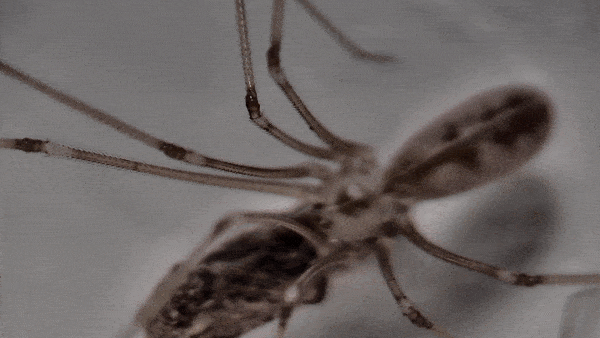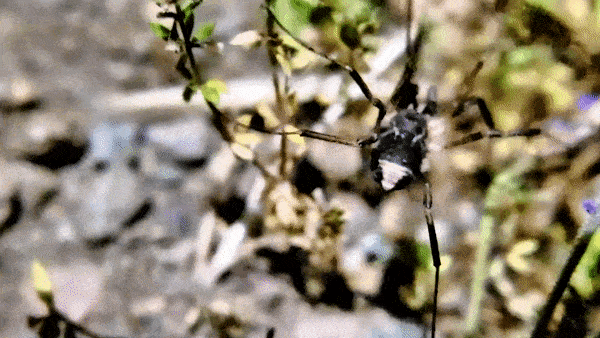Hello folks who wonder if companies employ toddlers to leverage their tiny hands to milk almonds or oats for our plant based milk,
Doesn't it annoy you when a colleague comes to your desk and starts staring at your desktop screen. So, you get pissed and politely excuse yourself to the only place you feel secure.
The restroom stall with 2 inch wide slits on the doors, where you think "Gosh! Is it that hard for these folks to respect my privacy?"
Similarly, one of the things that irks me is when people use the term "Daddy longlegs" to anything that has long legs be it Usain Bolt, Cellar spider or Harvestmen.
So let's settle that debate in this post.
First of all, Usain Bolt is automatically disqualified because he has now retired and is effectively no longer in our hearts.
So ultimately the match for the Daddy Longlegs title is between the Cellar Spider and the Harvestmen(which is not a spider).
On the left we have the spider commonly found in our cellar and attics, the featherweight champion "Cellar Spider" *crowd applauds
On the right, we have an arthropod commonly found walking on the trails at night, the welterweight champion "Harvestmen"(yes that is correct, it's not harvestman). *silence, person clears throat and then a couple of claps
Round 1: Eyes
Cellar Spider:
Cellar spiders have 8 eyes just like the rest of spiders you share your rooms with and the ones you intentionally crush by stepping on. Though they have a large number of eyes, its one of their weakest assets because they rely on the vibrations on the web to detect prey.
Below is the unique eye arrangement for the cellar spider. Wonder how eyes can help you tell what kind of spider is it, check this post.
Harvestmen:
Harvestmen have just 1 pair or 2 eyes which is not necessarily bad, because they spend less time and money at the optometrist. Also, it is an asset not utilized for finding food, as they use their legs as antennae to detect food in front of them.
Below you can see a harvestmen sporting its one pair of eyes minus the sunglasses.
Round 2: Diet
Cellar Spider:
Cellar spiders will eat any insect that lands on its web which is not sticky, so they have to be quick on their feet(literally) and then wrap the victim before injecting the venom which will neutralize the target and dissolve their internal organs which the spider can then slurp just as most of you do with your kale smoothies.
Below is a cellar spider holding on to its wrapped food which in this case was a stink bug.
Harvestmen:
If one arachnid was meant to survive the empty supermarket shelves because others were hoarding, put your money on this horse. Harvestmen are omnivorous eating everything from spiders, bird droppings, fungi, millipedes, plant matter, fruits and nuts. Also unlike the spider, harvestmen will bite off chunks of their food one at a time, then mix some fluid to those bits of food before swallowing. That is a disadvantage if it ever gets a Jamba Juice gift card from its uncle at Christmas.
Round 3: Body segments
Cellar Spider:
Spiders have 2 body segments. The front segment is called the Cephalothorax and the one on the back is the abdomen. This is great if it wants to mix and match its attire for the holiday party at work, but it also means it ends up spending more on its clothing so it does not become a pariah.
Below are the 2 distinct body segments visible on the Cellar spider.
Harvestmen:
Harvestmen have a single body segment which is great for saving on clothing but then it is limited to wearing dresses at all those pretentious parties.
Below one can see the single body segment with one pair of eyes on the harvestmen.
Round 4: Legs
Cellar Spider:
The spider has 8 legs that it uses to spin webs and wrap its prey as shown below.
Harvestmen:
The harvestmen has 8 legs among which it uses 1 pair to detect food by tapping them in front of it as it walks as shown below.
Round 5: Venom
Cellar Spider:
The cellar spider uses venom to subdue prey but is not potent enough to cause harm to humans.
Below is a cellar spider that will scamper to a safe place if a human gets too close.
Harvestmen:
The harvestmen do not have venom, hence they will avoid prey larger than itself and will not be able to cause harm to humans.
Round 6: Evolution
Cellar Spider:
The cellar spider evolved 180 million years ago which means it has its own share of stories to tell which ranges from the civil war to secretly selling booze during the Prohibition.
Harvestmen:
The harvestmen evolved 400 million years ago which means it has seen everything from a landline phones to dial-up internet to owning a Blockbuster account for renting DVD's. It also has some juicy gossip about the dinosaurs that is too hard to pass.
Verdict
So what's the verdict, who gets to keep the title of Daddy longlegs?
Well, because we live in an era where everyone gets a participant trophy, it would not be politically correct to declare one contestant a winner and the other a loser. Hence in the best interest of the society, we should call them by their common names of "Cellar spider" and "Harvestmen" respectively and forgo using the term Daddy longlegs for either one of them.
Doesn't it annoy you when a colleague comes to your desk and starts staring at your desktop screen. So, you get pissed and politely excuse yourself to the only place you feel secure.
The restroom stall with 2 inch wide slits on the doors, where you think "Gosh! Is it that hard for these folks to respect my privacy?"
Similarly, one of the things that irks me is when people use the term "Daddy longlegs" to anything that has long legs be it Usain Bolt, Cellar spider or Harvestmen.
So let's settle that debate in this post.
First of all, Usain Bolt is automatically disqualified because he has now retired and is effectively no longer in our hearts.
So ultimately the match for the Daddy Longlegs title is between the Cellar Spider and the Harvestmen(which is not a spider).
On the left we have the spider commonly found in our cellar and attics, the featherweight champion "Cellar Spider" *crowd applauds
On the right, we have an arthropod commonly found walking on the trails at night, the welterweight champion "Harvestmen"(yes that is correct, it's not harvestman). *silence, person clears throat and then a couple of claps
Cellar Spider:
Cellar spiders have 8 eyes just like the rest of spiders you share your rooms with and the ones you intentionally crush by stepping on. Though they have a large number of eyes, its one of their weakest assets because they rely on the vibrations on the web to detect prey.
Below is the unique eye arrangement for the cellar spider. Wonder how eyes can help you tell what kind of spider is it, check this post.
Harvestmen have just 1 pair or 2 eyes which is not necessarily bad, because they spend less time and money at the optometrist. Also, it is an asset not utilized for finding food, as they use their legs as antennae to detect food in front of them.
Below you can see a harvestmen sporting its one pair of eyes minus the sunglasses.
Cellar Spider:
Cellar spiders will eat any insect that lands on its web which is not sticky, so they have to be quick on their feet(literally) and then wrap the victim before injecting the venom which will neutralize the target and dissolve their internal organs which the spider can then slurp just as most of you do with your kale smoothies.
Below is a cellar spider holding on to its wrapped food which in this case was a stink bug.
If one arachnid was meant to survive the empty supermarket shelves because others were hoarding, put your money on this horse. Harvestmen are omnivorous eating everything from spiders, bird droppings, fungi, millipedes, plant matter, fruits and nuts. Also unlike the spider, harvestmen will bite off chunks of their food one at a time, then mix some fluid to those bits of food before swallowing. That is a disadvantage if it ever gets a Jamba Juice gift card from its uncle at Christmas.
Cellar Spider:
Spiders have 2 body segments. The front segment is called the Cephalothorax and the one on the back is the abdomen. This is great if it wants to mix and match its attire for the holiday party at work, but it also means it ends up spending more on its clothing so it does not become a pariah.
Below are the 2 distinct body segments visible on the Cellar spider.
Harvestmen have a single body segment which is great for saving on clothing but then it is limited to wearing dresses at all those pretentious parties.
Below one can see the single body segment with one pair of eyes on the harvestmen.
Cellar Spider:
The spider has 8 legs that it uses to spin webs and wrap its prey as shown below.
The harvestmen has 8 legs among which it uses 1 pair to detect food by tapping them in front of it as it walks as shown below.
Cellar Spider:
The cellar spider uses venom to subdue prey but is not potent enough to cause harm to humans.
Below is a cellar spider that will scamper to a safe place if a human gets too close.
The harvestmen do not have venom, hence they will avoid prey larger than itself and will not be able to cause harm to humans.
Round 6: Evolution
Cellar Spider:
The cellar spider evolved 180 million years ago which means it has its own share of stories to tell which ranges from the civil war to secretly selling booze during the Prohibition.
Harvestmen:
The harvestmen evolved 400 million years ago which means it has seen everything from a landline phones to dial-up internet to owning a Blockbuster account for renting DVD's. It also has some juicy gossip about the dinosaurs that is too hard to pass.
Verdict
So what's the verdict, who gets to keep the title of Daddy longlegs?
Well, because we live in an era where everyone gets a participant trophy, it would not be politically correct to declare one contestant a winner and the other a loser. Hence in the best interest of the society, we should call them by their common names of "Cellar spider" and "Harvestmen" respectively and forgo using the term Daddy longlegs for either one of them.










No comments:
Post a Comment
Did you learn something new in this post? Let us know in the comments below